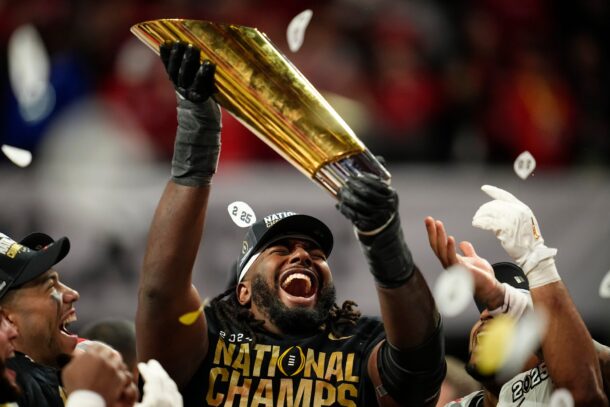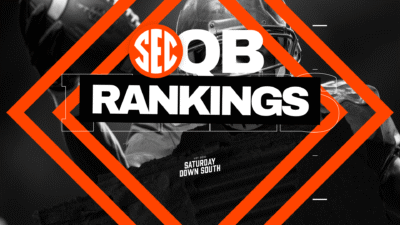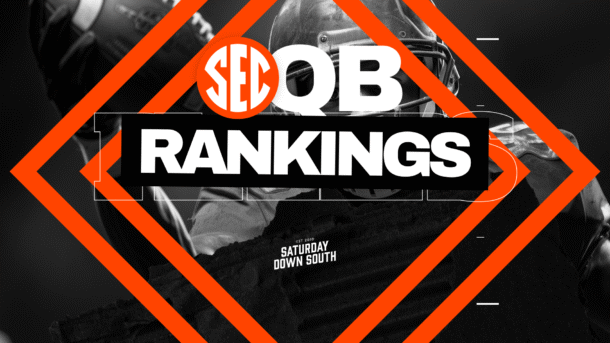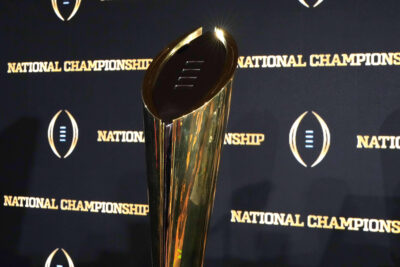
How the College Football Playoff format change impacts the 2025 futures market
Neither the layoff nor the format was to blame for Oregon losing to Ohio State in the second round of last year’s College Football Playoff. To a man, the Ducks were outplayed. Ohio State was the better team.
“We had an opportunity,” said Oregon head coach Dan Lanning after the Ducks lost 41-21 at the Rose Bowl. “We didn’t take advantage of the opportunity. I am not going to make excuses for our opportunity.”
Oregon went 12-0 in the regular season last fall, winning by an average of 17 points per game. The Ducks won a nonconference game against an eventual Playoff participant (Boise State), beat Ohio State at home on Oct. 12, and dominated a conference road game at Michigan. Oregon beat Penn State, another Playoff team, in the Big Ten Championship Game by 8 points.
As the only 13-0 team in the field, Oregon was the clear choice for the top overall seed.
The reward for a splendid season was a 20-day layoff and an opening matchup against the eventual national champions.
“If I was an Oregon fan — I have to say this because this kind of bothers me — and you’re the 13-0 No. 1 seed, and you’ve got to play Ohio State in the [second] round… I’m not an Internet guy, but if I was an Oregon fan, I’d be on the Internet screaming about that,” Nick Saban said on The Pat McAfee Show in January.
Oregon lost its first game of the CFP, as did each of the other 3 teams that earned a first-round bye as a top-4 seed.
In the aftermath, college football leaders unanimously voted to change the format and move to a straight seeding model. The 4 highest-ranked conference champions still get a financial boost for their efforts, but the CFP selection committee’s ranking is the ultimate letter of the law now.
Had the new format been the one the CFP went with from the beginning, Oregon would not have met Ohio State until the national championship round last winter.
The field would have looked like this:
12-seed Clemson at 5-seed Notre Dame
11-seed Arizona State at 6-seed Ohio State
10-seed SMU at 7-seed Tennessee
9-seed Boise State at 8-seed Indiana
Rather than receiving a first-round bye, Arizona State and Boise State would have been playing first-round games on the road.
The Clemson-Notre Dame winner would have faced Penn State in the second round. The Boise State-Indiana winner would have played Oregon. This side of the bracket would have produced the first semifinal.
The ASU-OSU winner would have played Texas. The SMU-Tennessee winner would have played Georgia.
Does Oregon win a second-round game against Indiana or Boise State? It’s certainly not a given. The Ducks needed a last-minute field goal to get by Boise State at home the first time. But you would have liked the Ducks’ chances to advance to the semis. They had already beaten Penn State. And my guess is Oregon would not have gotten rolled in a national final by Ohio State the same way it did in the second round.
Instead, we got a bracket that favored 2 teams that lost their respective conference title games. The Longhorns were a double-digit favorite over their first-round opponent, the largest spread of any of the first-round games. They had the shortest odds of any team in the field to make the semifinals. I wrote this on Texas back when the bracket was revealed:
Texas does not have a single win over a team that was ranked in the committee’s final Top 25. In fact, Texas only has 4 wins all season over teams that lost fewer than 6 total games. The Longhorns beat a Colorado State team that finished 8-4, a Michigan team that finished 7-5, a Florida team that finished 7-5, and a Texas A&M team that finished 8-4. Those are the best wins.
Texas played 2 games against a Playoff-caliber opponent. One of them was at home, the other was on a neutral field. Texas lost both.
And yet the Longhorns’ first-round opponent is a 3-loss team that is in the field purely because of a walk-off field goal in the ACC title game. Clemson lost to South Carolina and got handled by Georgia. The Tigers’ only ranked win is over SMU.
In the end, the most talented team won the national championship and that has been the endgame for college football’s power brokers for years. So, the hand-wringing about how we got there is interesting. Changing the format after only 1 year indirectly implies that the winner was only such because of a flaw, doesn’t it?
I don’t think that’s what the change actually signals. Rather, I think college football is trying to pull every lever possible to ensure the “best” team wins the title.
Though it was the preseason favorite to win it all, Ohio State had the fifth-shortest odds to win the national championship when the bracket was announced. Georgia was the favorite. Oregon was next, followed by Penn State and Texas.
The format tweak pretty much ensures that the top overall seed will be the betting favorite to win the whole thing.
Does it mean the top seed will actually win the whole thing? We’ll find out in the fall.
At bet365, Ohio State currently has the best national championship odds of anyone. The Buckeyes are +500 to win outright in 2025. Texas (+550) is next. Georgia (+650), Oregon (+750), and Penn State (+800) round out the top 5. There’s a clear delineation between that group and the next grouping of Alabama, Clemson, and Notre Dame, which all have +1400 odds.
Tennessee (+1800) and LSU (+2000) round out the top 10.
Last season, Ohio State was the most talented, and Ohio State won. I’d argue the Michigan loss was all that stood between Ohio State and the No. 1 overall seed in the field. (We could also argue that Ohio State doesn’t win the title without the Michigan loss, but I digress.) And I think that loss had a ton of noise to it.
So, what value does “the most talented team” bring? Regardless of who the first opponent is, to win a national championship in a 12-team Playoff, someone is going to have to beat 1 or 2 very good teams along the way.
With a future NFL Draft pick at quarterback a roster that has been retrofitted with an elite transfer class, one could make the argument LSU is the most talented team in the country. If Arch Manning lives up to the sky-high expectations, Texas is arguably the most talented team in the country. If Gunner Stockton proves to be a more stable option than Carson Beck was, Georgia can argue it is the most talented team in the country.
I would bet that the more important distinction will be “SEC/Big Ten champion.” It is unlikely the winner of either super league will have more than 2 losses, so it’s highly likely that the better of the 2 champions will be the No. 1 overall seed in the field.
Clemson was ranked 17th in SP+ at the start of the CFP. Arizona State was 30th in SP+. Indiana was 10th and Boise State was 22nd. That’s a great part of the bracket to be on. And because there was no change to the types of teams that will be selected, only the way they will be arranged, that part of the bracket will remain a great side to be on in 2025.
As such, I think betting on the national champion in 2025 comes down to betting on who you think wins the SEC and the Big Ten. The 1-seed will get the teams who won their conferences to “sneak” into the field. The 2-seed will get a gauntlet.
If I had to pick who wins each conference right now, I’d go with Georgia and Penn State, respectively.
LSU probably has some value as a darkhorse play at +2000 to win the national championship, but I just don’t see the Tigers earning the No. 1 overall seed in the field — my colleague does — and it’s hard to envision Brian Kelly winning 2 or 3 toss-up games in a row.
The 1-seed is going to be a major favorite in its opening game and a decent favorite in its second game. After that, they’re playing for the trophy.
Back the team you think is winning the 2 toughest conferences in the sport. If you think that’s Texas, ride the Longhorns. If you think that’s Ohio State, ride the Buckeyes. The 5- and 6-seeds no longer have the easiest path to a title. That’s my biggest takeaway from the latest CFP shakeup.
RELATED: Want to bet on the futures market for the 2025 college football season? Grab this bet365 promo code and you’ll get an additional $150 in bonus bets added to your account when you make your first $5 bet.
Derek Peterson does a bit of everything, not unlike Taysom Hill. He has covered Oklahoma, Nebraska, the Pac-12, and now delivers CFB-wide content.






